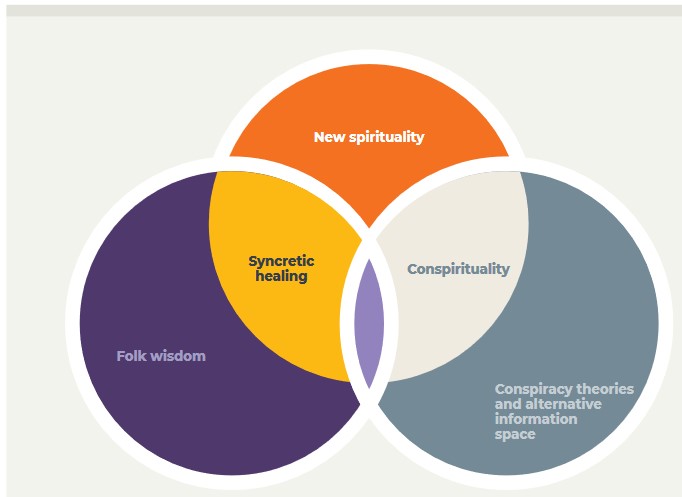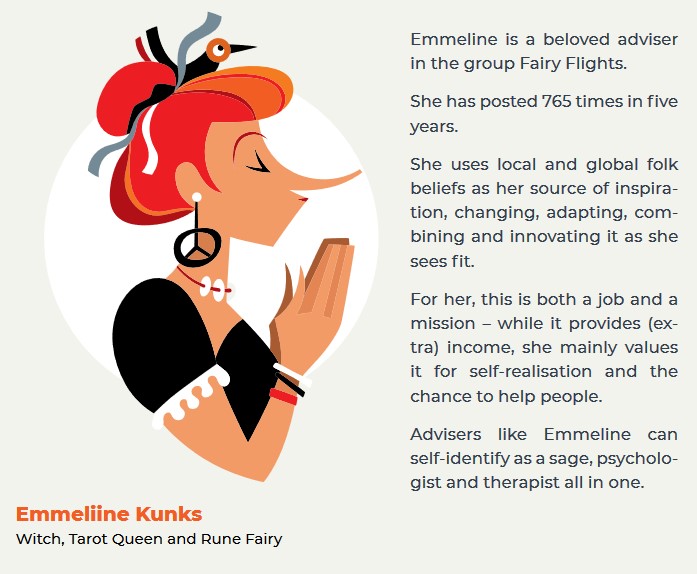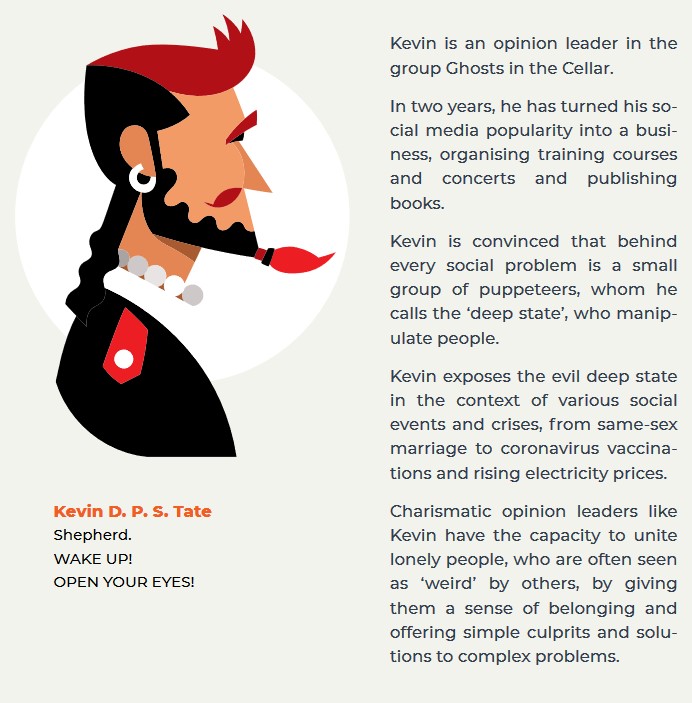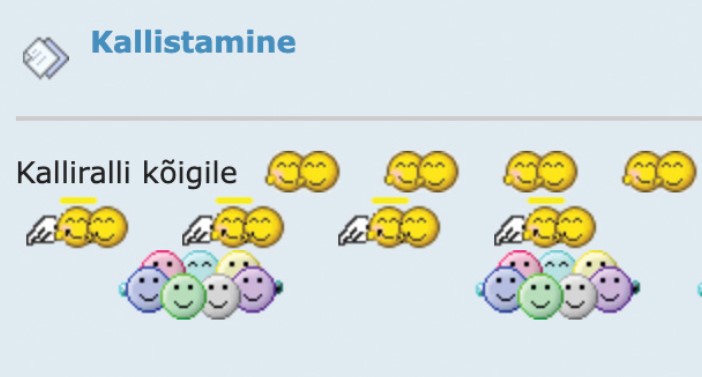Participatory culture and digitally mediated mental well-being practices
New practices, beliefs, and even technological innovations emerge where the internet meets mental health. This article focuses on informal social media groups that offer alternative interpretations of mental health issues and solutions to them. We use the term ‘participatory culture as mental health’ to describe the socialising health behaviour enabled and mediated by digital and internet technology and combining various information sources. It is about creating and consuming online content and communicating about mental wellbeing, including offering support and asking for help. As a result, new relationships, roles and hierarchies emerge between people, as well as new ways of interpreting the world.
Participatory culture as mental health can be research-based (e.g. support groups that bring together people with a specific diagnosis or experience) and thereby support the visions of health organisations. But groups operating parallel to them, whose ideas might conflict with institutional views, are also widespread. This article analyses new-spiritual, conspiritual and folk-wisdom social media groups that create interpretations diverging from institutional views. We use ‘alternative interpretation groups’ as an umbrella term to describe all these collectively (see Figure 4.2.1 for the links between different alternative interpretations).

‘Folk wisdom’, which refers to the transgenerational collection of the life experiences of ancestors, is a term familiar to many. However, new spirituality and conspirituality are probably less well known. ‘New spirituality’ is an umbrella term that includes the more esoteric neo-pagan practices such as witchcraft and shamanism; meditation and mindfulness, which are gaining popularity as science-based in the Western world; and reiki and yoga, which blur the boundaries of sports, health behaviour and spirituality. New spirituality is characterised by syncretism, or mixing modern and ancient, spiritual and physical, religious and secular, local and foreign ideas and practices and combining them based on preferences and needs (Uibu 2016). When new spirituality is accompanied by a belief in conspiracy theories and pseudoscience, it is described as ‘conspirituality’ (from the words ‘conspiracy’ and ‘spirituality’). In the broadest sense, conspiritual groups are united in their opposition to the mainstream.
This article analyses what is happening in alternative interpretation groups from a wider cultural and historical perspective. In doing so, we do not judge the members, activities and beliefs of the groups, as their activity can both support and undermine mental health. We discuss the consequences of participatory culture as mental health that appear in alternative interpretation groups. In the conclusion, we will offer some recommendations for policymakers, mental health experts and general readers who may be interested in such groups.
People’s choices and available options should always be seen from their cultural, social and historical perspectives. Estonia’s current vision for mental health considers self-help and community support critically important as a base level of activities and services supporting mental health (see Figure 1.5.1; Randver et al. in Chapter 1).
The Green Paper on Mental Health (Ministry of Social Affairs 2020) defines self-help as activities initiated by the person themselves, their family or the community (including colleagues) to maintain positive mental health (including learning skills), prevent problems, or promote, improve or restore health. In that document, a community is understood as a network of people who are geographically or socially close. Community support could be provided as services by local governments or as informal support by the initiatives of people in neighbourhoods, village movements and church congregations. Regarding the latter, it is important to note that only 13–16% of the Estonian population report believing in God (Eurobaromeeter 2005).
Although self-help and community help are mentioned in strategic documents, they are poorly integrated into the institutional system.
The Estonian health system is medicine-oriented but suffers from a shortage of resources. We lack psychiatrists, clinical psychologists, school psychologists, mental health nurses and general practitioners. The continued stigmatisation of mental health issues is also a barrier to wellbeing. According to a 2016 survey, 35% of the population agrees with the statement that a person’s lack of willpower causes mental disorders, and 62% do not want to discuss their mental health problems with anyone (Ministry of Social Affairs 2016).
At the same time, folk medicine continues to be held in high regard in Estonia, and as many as 59% of the population believes in ‘a higher power or people with superpowers’ (Kantar Emor 2017). The media plays an important role in discussing spiritual, magical and traditional ideas. Healers and witches have been portrayed as heroes since the Soviet era (Kõiva 2015). Even today, media content related to magic and superpowers is extremely popular (Vahter 2018). Considering that Estonians are active internet users, it is not surprising that alternative interpretation discussions have largely moved to social media in recent years. The most popular platform in Estonia – Facebook – has hundreds of new-spiritual, conspiritual and folk-wisdom groups, the largest of which have over 30,000 members. We have been investigating groups like these since 2015.
The following statements are based on the analysis of participant observation data, fieldwork notes, about 1,000 posts and 20 in-depth interviews collected over six years. For ethical reasons, we have not mentioned the names of any groups or users and illustrate the research with ‘ethnographic mock-ups’, which imitate the patterns emerging from the analysis but are not copies of any posts or profiles.
The membership of alternative interpretation groups is sociodemographically diverse. Although smaller groups may attract people of similar backgrounds (e.g. level of education or gender), differences even out in larger groups, and the broader field of participatory culture as mental health on Facebook features a variety of interest groups.
Users with greater perceived expertise can become influencers within alternative interpretation groups if they can present their ideas in a form suitable for the group and platform and frame them convincingly for the group members (McCosker 2018). Users can achieve expert status by posting actively and continuously, whether they post their opinions or provide assistance. In new-spiritual and folk-wisdom groups, experts often refer to themselves as witches, healers, sages, shamans, spiritual guides and the like. When advising and helping people, they rely on naturopathy, personal experiences, and magical techniques such as using a pendulum or card reading (vt Figure 4.2.2). Simultaneously, they offer their products, services and advice in public groups and in private channels (Facebook Messenger, Skype, Zoom, WhatsApp, by phone or in home visits).

The experts in new-spiritual groups mainly stand out by sharing folk wisdom and giving advice, while in conspiritual groups, those offering new interpretations of social developments tend to achieve a higher status. By posting online, they hope to achieve recognition as (paid) counsellors or coaches, organise courses, publish self-help books, and sometimes break into the mainstream media. The latter aids in further expanding the scope of conspiritual ideas (see Figure 4.2.3.).

In addition to the influencers, there are also the gatekeepers, although social media is typically thought to lack them. This absence has been associated with both a more democratic participatory culture and the spread of false information because unlike centralised media, participation is not regulated. However, alternative interpretation groups have a new type of influential gatekeeper: group administrators. They shape the discussion with Facebook’s content management tools, which allow them to remove content, accept new members, set rules and enforce them at their discretion.
People come to new-spiritual, conspiritual and folk-wisdom social-media groups for different reasons. Interest in alternative or existential topics, significant life events, certain lifestyles or values, and the desire to develop oneself in these areas are some of the reasons why people join these groups.
Dissatisfaction with the prevailing social order, a feeling of loneliness and missing out, and a lack of trust in the mainstream, be it institutional medicine, science, media or government, can also be the reasons. People’s interest and willingness to participate, and their acceptance of the meanings and values in these groups, develop gradually.
In more practical cases, specific concerns or questions may bring people to these groups. In this way, people seek solutions to a wide range of questions directly or indirectly related to mental wellbeing: relationship problems, grief, professional failures, workplace bullying or illness. New-spiritual and folk-wisdom groups also seek to predict the future and interpret signs of the spiritual world. Posters may or may not describe their problems as related to mental health. In some cases, they complain of depression, anxiety, loneliness and feelings of inferiority. In other cases, it is a matter of a long-term lack of wellbeing and multifaceted problems. For example, a person may approach the group with concerns that they are experiencing hair loss, but only through a dialogue with the helpers is it revealed that the health problem is due to long-term stress caused by family quarrels and a cut in income.
The size of the group and the number of people offering help are important for those seeking help. As a result of the network effect, answers are faster, more varied and more flexible in large groups than when asking friends and relatives one by one.
However, the fact that the group members and the solutions they offer are varied, means that a person complaining about anxiety or domestic violence may be advised to go to a support centre or talk to a psychologist, solve their problems by smiling, forgiving or being grateful, or have a curse or evil eye removed by a group expert.
For many members, the alternative interpretation groups studied here are one of the few places where they can openly talk about topics important to them, experience an understanding and warm attitude, and feel valuable. However, social media does not offer like-minded people and support only to those struggling with (mental) health and relationships. People who distrust authorities, including authorities in government, science and medicine, also gather in these groups. A sense of belonging fosters a faster and deeper acceptance of alternative ideas. This explains the development of emotional truths that are not scientifically supported but are perceived as true.
SOCIAL MEDIA AND MENTAL HEALTH
Social media allows charismatic individuals familiar with the platform’s possibilities to find a much wider audience than before. Moreover, the status achieved in social media creates a false consensus among members, whereby people with marginal ideas that have received some attention begin to feel that a much larger number of people agree with them than actually do. Social media also favours the deepening of marginal views because of people’s desire for continued attention.
Although people with lower levels of education, health literacy and trust in medicine are more vulnerable to health disinformation, it is a sense of belonging that largely drives the sharing and believing in disinformation. Sharing is based on the position of the original poster and the sharer’s desire to appear as a certain kind of person. Therefore, according to the latest studies, emotional intelligence protects against disinformation and helps people recognise manipulative content and analyse their own reactions and the reasons for them.
Alternative interpretation groups have developed their own systems of meaning, communication styles and symbols, which are held together by the concept of awakening.
Holism, harmony and ascribing meaning to everything are the dominant topics in new-spiritual groups. As a result of such a system of values, mental health problems are seen more as a developmental challenge and a natural aspect of awakening. Folk-wisdom groups characteristically describe problems and solutions through external actors. Thus, a mental health problem could be caused by the moon, aquifers or a curse, and wearing a red ribbon, plants or crystals can help. Attributing agency to objects and natural phenomena makes it possible, on the one hand, to explain difficulties and, on the other hand, to see those difficulties as valuable lessons on the path of spiritual development and awakening.
Many of these groups see helpful angels as the real actors. These angel groups mostly use the ‘language of kindness’: members are not criticised or attacked but are given support and encouragement to overcome difficulties (see Figure 4.2.4.). Although people who do not believe in angels might roll their eyes at this point, the language of kindness is an important part of emotional support and thus mental wellbeing.

Conspiritual groups also see connections everywhere but tend to explain these with secret agreements and manipulations rather than holistic unity. They rebuild solidarity using the language of exposure and criticism, not kindness and love Conspiritual solidarity on social media often turns into a crusade: calls for resistance and exposing the corrupt elite are frequent. However, these groups also talk about ‘awakening’ and ‘becoming aware’, and there is a sense of a ‘new era’ and momentous changes typical of the New Age movement, which are expected to bring about positive changes.
Participation in social media can simultaneously support and undermine mental health.
Sometimes the same course of action empowers people to a certain extent and then becomes a health risk. In other cases, group participation is empowering for the individual but harmful to social wellbeing. We will highlight both the supporting aspects and the problematic aspects as dialectical pairs that best describe the complex reality.
More support can create ideological bubbles and tension
Finding people who think about and have gone through the same things offers social and spiritual support. In all alternative interpretation groups, problems are discussed mainly through personal experiences. This destigmatises problems and talking about them. Finding people with similar experiences helps relieve tension, gives hope and definitely boosts mental wellbeing in the short term. Conspiritual groups, where members share a sense of disenfranchisement, perceived inequality, distrust of the elite and general alienation from society, also boost members’ self-esteem by ridiculing ‘the sheeple’ and ‘the elite’. In these groups, a deep sense of community often leads to activism and even political participation. Most sociological and political accounts of democracy would call this a positive development.
However, the activism of conspiritual groups is often destructive and based on disinformation. The more important group membership is to an individual’s mental health and sense of self, the more likely members are to isolate into an ideological bubble. Depending on the group’s beliefs, this may result in the creation of realities that harm the functioning of society as a whole, such as the development of parallel structures in various areas of life. Examples from the recent state of emergency during the pandemic include ‘vaccine-free’ kindergartens and lawyers handling complaints based on conspiracy theories.
Increased agency is accompanied by reduced privacy and safety risks
Alternative interpretation groups offer many people an opportunity for self-expression that they do not have elsewhere. This has an empowering effect on people, as it teaches introspection, self-analysis and taking responsibility for one’s (health) behaviour by observing the experiences and stories of others.
Facebook is built to encourage people to post more and more and to share their private lives; it does this through the user interface, algorithms, and its content management rules and their implementation (see Tiidenberg 2017). In support groups, people are even more inclined to talk about themselves publicly, as sharing more information about themselves leads to better advice.
However, many do not realise the reach of their posts or the amount of shared information when all pieces are put together. Public posts that suggest the poster is struggling with poor mental health can also attract those who seek to take advantage of people in need, for example, by offering loans or miracle cures or lifting a curse (see Renser and Tiidenberg 2020). The information shared in groups is controlled to some extent by group administrators and fellow group members, who can warn others. However, due to more active content management by the platform in the context of COVID-19, more and more disinformation and dubious promises move to private conversations, where those in need are even more vulnerable to manipulators.
Diverse and widely available information leads the spread of unscientific ‘emotional truths’
Informal online communities increase the availability and diversity of (mental) health information, mainly in the form of personal stories, which is why such groups serve as a source of information and learning. At the same time, the overabundance of online information and the possibility for multiple interpretations can place people in a maze of information or direct them to ‘emotional truths’ – that is, emotionally resonant disinformation that helps avoid cognitive overload. On social media, people in need receive advice from amateurs without professional training, who draw on tradition, alternative medicine, or, purportedly, messages from the angels or the universe. Sometimes these amateurs are helpful, but it can also happen that those in need of professional help go without it for too long, or the person in need no longer believes the experts because their advice clashes with the alternative interpretation.
Summary
The popularity of alt-interpretive groups reflects the unmet needs of a large segment of the population for belonging, support, being understood and cared for, self-realisation and spirituality. However, alt-interpretive groups have contradictory implications on the individual and the collective level, and these can change in time.
In the short term, this kind of involvement often supports the individual’s mental health. The groups fill the gaps created by the shortage of mental health professionals, evidence-based self-help and community-based services in Estonia. From the individual’s perspective, increased agency, a sense of belonging and finding support, and easier access to diverse information reflecting life experiences can be considered positive.
In the long run, however, alternative interpretation groups can harm both individual wellbeing and social solidarity. The spread of pseudoscience and disinformation in alternative interpretation groups is dangerous, and sometimes it amounts to antisocial activism. People with mental health problems can therefore miss out on science-based help, and in the worst case, their condition can deteriorate to the point where the person becomes a threat to themselves or others. Participation in groups also carries privacy and safety risks, and people in need may be exploited. Isolating into ideological bubbles and the accompanying polarisation can also be dangerous at the societal level.
However, it is important to keep in mind that the points discussed here are only one specific part of participatory mental health practices. Due to insufficient data for Estonia, we could not discuss the more professional and pro-social examples of participatory practices, such as web-based mindfulness apps, which are currently being studied.
Finally, here are some recommendations for policymakers, mental health professionals and also general readers who may join or be interested in groups such as those discussed above.
- It is important to increase access to science-based support services linked to self-help or community help, both online and in the physical environment (e.g. experience counselling or group discussions in local centres, mobile applications, initiatives such as Peaasi.ee and Vaikuseminutid in Estonia), is important. We know from international experience that professionally initiated and moderated social media groups and online portals can also become centres of self-help and community help. Professional mental health help or crisis counselling should be quickly available for people in difficult situations.
- Mental health influencers and gatekeepers active in social media (e.g. administrators and moderators of folk-wisdom groups) should receive training and be involved in health campaigns.
- One option worth considering would be to incorporate the gatekeepers of the existing alternative interpretation groups into national communication strategies concerning mental health and other such issues. Recognising them as important stakeholders instead of excluding them from mainstream influence might reduce confrontation and encourage dialogue.
- Mental health professionals should be aware that such groups exist and can have a significant and often multifaceted influence on people’s healthcare decisions.
- Communication guidelines should be developed for mental health professionals to help them engage in dialogue and counsel patients who believe in alternative interpretations and make healthcare decisions based on them, including those who refuse treatment.
- The curricula of general education schools should place greater emphasis on the development of self-awareness, self-regulation and empathy for the sake of both stronger mental health and more competent online behaviour.
- Avoiding stigmatisation and building bridges should be one of the goals of mental health communication in the public sector.
- As members of participatory and alternative interpretation groups make up a significant part of the Estonian population, it is necessary to invest in specific research to understand the dynamics of these groups and facilitate dialogue between scientific and alternative interpretations.
Eurobarometer. (2005). Social values, science & technology [Report]. Special Eurobarometer 225/Wave 63.1. https://data.europa.eu/data/datasets/s448_63_1_ebs225?locale=en
Kantar Emor. (2017, 16. märts). Emor Passwordil: üle poole eestlastest usub kõrgemaid jõude ning ülivõimetega inimesi. Kantar Emor. https://www.emor.ee/blogi/emor-passwordil-ule-poole-eestlastest-usub-korgemaid-joude-ning-ulivoimetega-inimesi/
Kõiva, M. (2015). Saatekirjaga rahvaarsti juures. Mäetagused. Hüperajakiri, (62), 25-54.
McCosker, A. (2018). Engaging mental health online: Insights from beyondblue’s forum influencers. New Media and Society, 20(12), 4748–4764. https://doi.org/10.1177/1461444818784303
Preston, S., Anderson, A., Robertson, D.J., Shephard, M.P. & Huhe, N. (2021). Detecting fake news on Facebook: The role of emotional intelligence. PLoS ONE, 16(3). https://doi.org/10.1371/journal.pone.0246757
Renser, B. & Tiidenberg, K. (2020). Witches on Facebook: Mediatization of Neo-Paganism. Social Media + Society , 6(3). doi:10.1177/2056305120928514
Schulz, A., Wirth, W., & Müller, P. (2020). We Are the People and You Are Fake News: A Social Identity Approach to Populist Citizens’ False Consensus and Hostile Media Perceptions. Communication Research, 47(2), 201–226. https://doi.org/10.1177/0093650218794854
Sotsiaalministeerium. (2016). Elanikkonna teadlikkus, suhtumine ja hoiakud vaimse tervise teemal. Elanikonna küsitlus. Sotsiaalministeerium. https://www.sm.ee/sites/default/files/content-editors/eesmargid_ja_tegevused/Norra_toetused/Rahvatervise_programm/elanikkonna_teadlikkus_suhtumine_ja_hoiakud_vaimse_tervise_teemadel_2016.pdf
Sotsiaalministeerium. (2020). Vaimse tervise roheline raamat. Sotsiaalministeerium. https://www.sm.ee/sites/default/files/news-related-files/vaimse_tervise_roheline_raamat_0.pdf
Tiidenberg, K. (2017). Ihu ja hingega internetis: Kuidas mõista sotsiaalmeediat. Tallinna Ülikooli Kirjastus.
Uibu, M. (2016). Religiosity as Cultural Toolbox: A Study of Estonian New Spirituality. Tartu Ülikooli kirjastus.
Vahter, T. (2018, 3. oktoober). Esoteerika vabariik. ERR. https://kultuur.err.ee/866096/tauno-vahter-esoteerika-vabariik